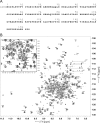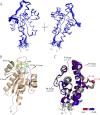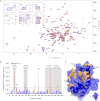The apo-structure of the low molecular weight protein-tyrosine phosphatase A (MptpA) from Mycobacterium tuberculosis allows for better target-specific drug development
- PMID: 22888002
- PMCID: PMC3464563
- DOI: 10.1074/jbc.M112.399261
The apo-structure of the low molecular weight protein-tyrosine phosphatase A (MptpA) from Mycobacterium tuberculosis allows for better target-specific drug development
Abstract
Protein-tyrosine phosphatases (PTPs) and protein-tyrosine kinases co-regulate cellular processes. In pathogenic bacteria, they are frequently exploited to act as key virulence factors for human diseases. Mycobacterium tuberculosis, the causative organism of tuberculosis, secretes a low molecular weight PTP (LMW-PTP), MptpA, which is required for its survival upon infection of host macrophages. Although there is otherwise no sequence similarity of LMW-PTPs to other classes of PTPs, the phosphate binding loop (P-loop) CX(5)R and the loop containing a critical aspartic acid residue (D-loop), required for the catalytic activity, are well conserved. In most high molecular weight PTPs, ligand binding to the P-loop triggers a large conformational reorientation of the D-loop, in which it moves ∼10 Å, from an "open" to a "closed" conformation. Until now, there have been no ligand-free structures of LMW-PTPs described, and hence the dynamics of the D-loop have remained largely unknown for these PTPs. Here, we present a high resolution solution NMR structure of the free form of the MptpA LMW-PTP. In the absence of ligand and phosphate ions, the D-loop adopts an open conformation. Furthermore, we characterized the binding site of phosphate, a competitive inhibitor of LMW-PTPs, on MptpA and elucidated the involvement of both the P- and D-loop in phosphate binding. Notably, in LMW-PTPs, the phosphorylation status of two well conserved tyrosine residues, typically located in the D-loop, regulates the enzyme activity. PtkA, the kinase complementary to MptpA, phosphorylates these two tyrosine residues in MptpA. We characterized the MptpA-PtkA interaction by NMR spectroscopy to show that both the P- and D-loop form part of the binding interface.
Figures







Similar articles
-
The domain architecture of PtkA, the first tyrosine kinase from Mycobacterium tuberculosis, differs from the conventional kinase architecture.J Biol Chem. 2018 Jul 27;293(30):11823-11836. doi: 10.1074/jbc.RA117.000120. Epub 2018 Jun 8. J Biol Chem. 2018. PMID: 29884774 Free PMC article.
-
Oxidation of the Mycobacterium tuberculosis key virulence factor protein tyrosine phosphatase A (MptpA) reduces its phosphatase activity.FEBS Lett. 2022 Jun;596(12):1503-1515. doi: 10.1002/1873-3468.14348. Epub 2022 Apr 15. FEBS Lett. 2022. PMID: 35397176
-
Three-dimensional structure and ligand interactions of the low molecular weight protein tyrosine phosphatase from Campylobacter jejuni.Protein Sci. 2006 Oct;15(10):2381-94. doi: 10.1110/ps.062279806. Protein Sci. 2006. PMID: 17008719 Free PMC article.
-
Mechanistic studies on protein tyrosine phosphatases.Prog Nucleic Acid Res Mol Biol. 2003;73:171-220. doi: 10.1016/s0079-6603(03)01006-7. Prog Nucleic Acid Res Mol Biol. 2003. PMID: 12882518 Review.
-
Low molecular weight protein tyrosine phosphatase: Multifaceted functions of an evolutionarily conserved enzyme.Biochim Biophys Acta. 2016 Oct;1864(10):1339-55. doi: 10.1016/j.bbapap.2016.07.001. Epub 2016 Jul 13. Biochim Biophys Acta. 2016. PMID: 27421795 Review.
Cited by
-
Wzb of Vibrio vulnificus represents a new group of low-molecular-weight protein tyrosine phosphatases with a unique insertion in the W-loop.J Biol Chem. 2021 Jan-Jun;296:100280. doi: 10.1016/j.jbc.2021.100280. Epub 2021 Jan 12. J Biol Chem. 2021. PMID: 33450227 Free PMC article.
-
Mycobacterium tuberculosis Serine/Threonine Protein Kinases.Microbiol Spectr. 2014 Oct;2(5):10.1128/microbiolspec.MGM2-0006-2013. doi: 10.1128/microbiolspec.MGM2-0006-2013. Microbiol Spectr. 2014. PMID: 25429354 Free PMC article. Review.
-
Solution NMR Studies of Mycobacterium tuberculosis Proteins for Antibiotic Target Discovery.Molecules. 2017 Aug 31;22(9):1447. doi: 10.3390/molecules22091447. Molecules. 2017. PMID: 28858250 Free PMC article. Review.
-
Characterization and 1.57 Å resolution structure of the key fire blight phosphatase AmsI from Erwinia amylovora.Acta Crystallogr F Struct Biol Commun. 2016 Dec 1;72(Pt 12):903-910. doi: 10.1107/S2053230X16018781. Epub 2016 Nov 30. Acta Crystallogr F Struct Biol Commun. 2016. PMID: 27917839 Free PMC article.
-
Regulatory interactions between a bacterial tyrosine kinase and its cognate phosphatase.J Biol Chem. 2013 May 24;288(21):15212-28. doi: 10.1074/jbc.M113.457804. Epub 2013 Mar 30. J Biol Chem. 2013. PMID: 23543749 Free PMC article.
References
-
- World Health Organization (2012) 2011/2012 Tuberculosis Global Facts, World Health Organization, Geneva
-
- De Cock K. M., Chaisson R. E. (1999) Will DOTS do it? A reappraisal of tuberculosis control in countries with high rates of HIV infection. Int. J. Tuberc. Lung Dis. 3, 457–465 - PubMed
-
- Koul A., Arnoult E., Lounis N., Guillemont J., Andries K. (2011) The challenge of new drug discovery for tuberculosis. Nature 469, 483–490 - PubMed
-
- Clatworthy A. E., Pierson E., Hung D. T. (2007) Targeting virulence. A new paradigm for antimicrobial therapy. Nat. Chem. Biol. 3, 541–548 - PubMed
-
- Cozzone A. J., Grangeasse C., Doublet P., Duclos B. (2004) Protein phosphorylation on tyrosine in bacteria. Arch. Microbiol. 181, 171–181 - PubMed
Publication types
MeSH terms
Substances
LinkOut - more resources
Full Text Sources

